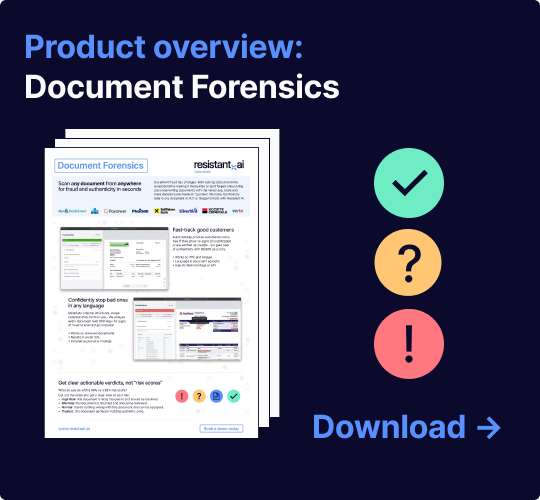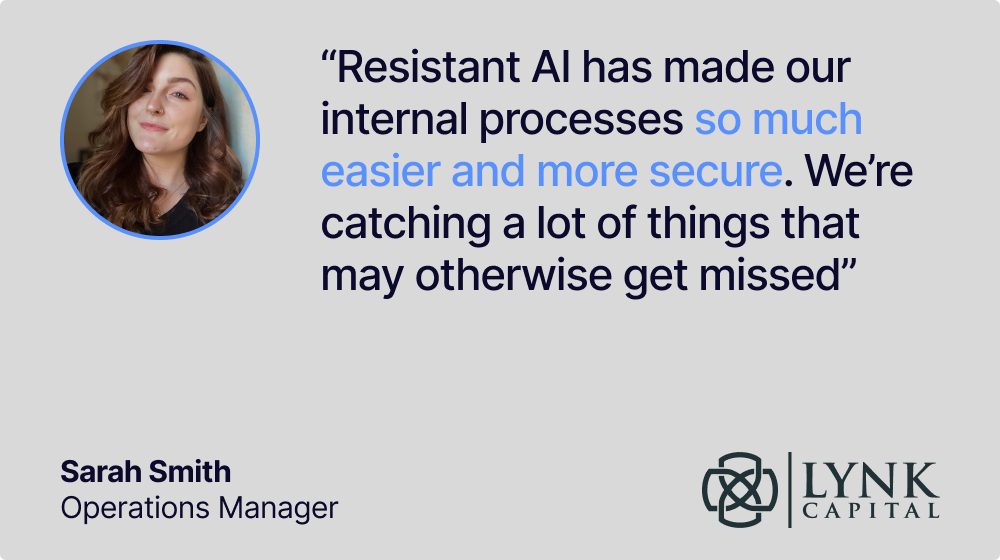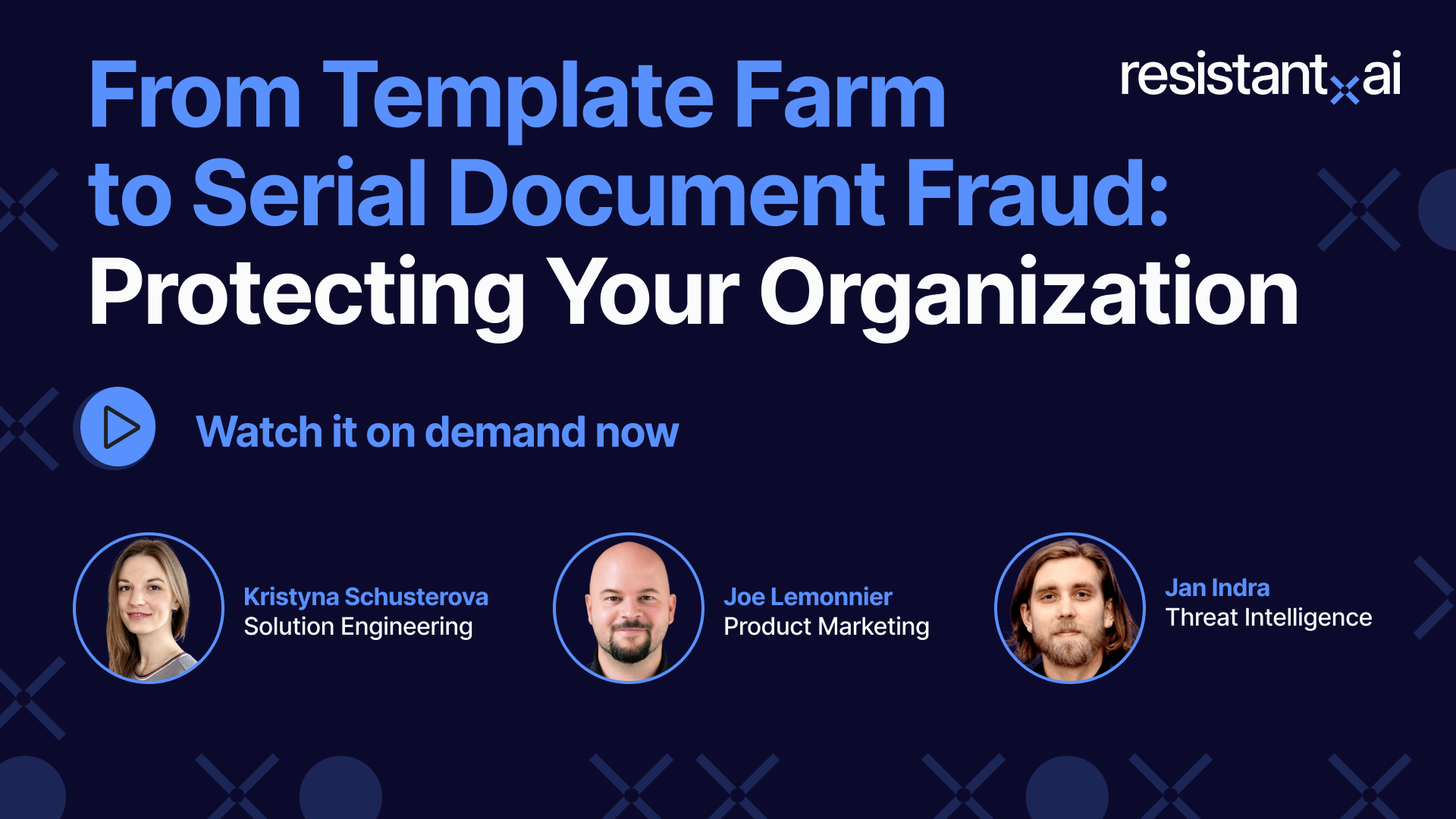13 Red flags of business loan fraud

As a lender, approving a loan to the wrong applicant leads down a slippery slope of profit loss.
In business loan application fraud, the risks of fraud in B2B lending and factoring are endless–yet, the business loan underwriting fraud prevention solution remains the same. To keep business loan scams at bay, identifying initial warning signs is vital. From falsified financial statements to poor business plans, malicious loan applicants are becoming creative in different ways to obtain funds illegally.
However, most lenders and financial institutions need to understand what techniques are effective in detecting loan application fraud. Since documents make up the bulk of any loan application process, lenders should be focused on B2B lending fraud detection–more specifically, on how to detect fraudulent documents in business loans. This can be done through stringent business loan underwriting guidelines, fraud detection specialists, and automated document verification tools for lenders.
Apart from the business loan fraud prevention methods put in place, additional red flags can also be strong indicators of loan fraud. To help you out, here are 13 signs to look out for in business loan application fraud:
1. Fake or forged documents
In every business loan application, submitted documentation is the gateway to understanding each applicant–in terms of behavior, habits, and creditworthiness. These documents can range from bank statements to pay stubs, depending on the type of loan applied. In order to know how to avoid fraud in digital lending, pay close attention to discrepancies such as fonts, formatting etc to secure document verification for loan underwriting. In addition, it is paramount that lenders understand what are the different types of B2B financial fraud in a guide to lending fraud detection to be better prepared for potential fraud.
2. Lack of audited financial statements
Any document can be falsified, and that includes financial statements or bank statements. For lenders, it is vital to obtain audited documents for the additional stamp of approval. This enforces the reliability and transparency of official documents since it is audited by an independent third party.
3. Financial discrepancies and abnormalities
Once an applicant submits their financial documents, any lender should pay particular attention to these aspects related to monetary gains or losses:
-
Irregular transactions with abnormal amounts not aligned with the business
-
Late payments to creditors, other lenders, loan repayments, and even bankruptcies
-
Repeated changes in bank accounts, company assets, overdrafts, and external auditors
-
Inflated revenue or assets that are not audited or aligned with the market value
-
Multiple credit lines from different financial institutions and lenders
-
Never payment–where a business never makes a single payment on existing debts
-
Unusual loan requests and repayment terms that deviate from the standard
-
Poor or unrelated assets and cash balances even though the business is earning high profit
These common tips vary from the type of loan application to the type of business but are set as a guideline for potentially fraudulent practices.
4. Data discrepancies
During business loan applications, basic information about the business and its franchise can be easily fabricated or forged. Lenders and financial institutions must spend time to determine the authenticity of every location–via Google Maps or even a satellite view. In addition, contradictory information such as using a personal mobile phone number or address as part of the business is a red flag for concern.
5. Poor physical presence
Most brick-and-mortar businesses should have a physical presence in each location. This could range from an office to a store but it should be searchable and identifiable on applications such as Google Maps. When it is not listed or visible on applications such as Google Satellite, it is a huge red flag that could indicate a ‘shell’ company.
6. Abysmal business plan
Once a business requests funding, its viability is highly dependent on the type of operations and value it can bring to consumers. As a financial institution and lender, your responsibility is to determine how profitable the firm can be to repay the loan quickly. One way to do this is to have deeper insight by analyzing and assessing their business plan–poor objectives, high costs with unsustainable revenue forecasts, and unclear target markets are usually signs of poor business planning.
7. Pressure on procedures
A loan applicant’s behavior goes a long way in helping lenders understand their trustworthiness and the possibility of defaulting payments. Some of these traits can include incessant loan applications either as an individual or business, unwillingness to verify or provide more information, and repeated requests for the approval of the loan.
8. Poor press and reputation
For lenders, paying attention to the media and recent news pays off. When a business obtains notoriety in the press for any situation, it is a red flag for concern during the loan process. It is important to include winding-up petitions or other legal issues that are part of a public record and should be analyzed before approving a loan. As a business, any form of bad press tends to have repercussions such as poorer brand image, dipped revenue, and many others. This could indicate financial distress and a potential default on loan repayments.
9. Repetitive changes
Another key point to note is the number of times the business has changed its external auditors. If it is regular and sudden–especially when facing trouble signing off accounts–it can be an indication of poor financial performance and management within the organization. This could highlight the firm’s inability to pay punctually.
10. Sudden disruptions
Stability is key for any organization. When there are sudden disruptions such as loss of dominant suppliers, termination of product supplies, and even late or phantom delivery of products–it can indicate poor management or financial distress like being unable to pay their main suppliers. These concerns are warning signals that highlight a business’s poor performance and ability to manage crises.
11. Deferred capital expenditure
Deferred expenses can range from advertising costs to prepayments of rent or insurance. However, when an organization has a large sum or consistent habit of huge deferred capital expenditure, it can be a potential risk for lenders or financial institutions. It is crucial to obtain more information on deferred expenses and how it can affect the company’s finances in the fiscal year before approving a loan.
12. Declining market
This can be a tricky aspect but any business that fails to have demand, will not be able to sustain itself long term. For financial institutions, assessing that is key to ensure approved loans are repaid. For example, no underwriter or lender should approve loans for organizations producing floppy disks since it is an obsolete technology.
13. Multiple businesses and no references
A person can have several businesses but the red flag occurs when the locations are all over with a lack of revenue. It indicates a lack of sustainability and possible fraud–which is why checking the location of an organization and its franchise is paramount. In addition, any business owner should have references with other financial institutions, suppliers, lenders, clients etc.
As fraudsters get creative with their defrauding methods, lenders and financial institutions have to keep up with the latest B2B lending fraud detection techniques in order to keep business loan application fraud at bay.
How to prevent loan application fraud
No matter the type of loan, the best way to prevent loan application fraud is through investing in B2B lending fraud detection methodologies for firms to safeguard their assets. This includes having a layered approach to combat business loan fraud effectively using a variety of tools.
Here are some ways to start:
Train in-house fraud detection specialists
A company’s best asset is their employees. For organizations to eradicate business loan application fraud, it is a collective effort that involves developing internal members such as fraud detection specialists and underwriters to spot fake documents.
This includes technical training on how to use advanced fraud detection techniques in loan underwriting and AI-based document verification for business loans–including a culture of knowledge transfer within employees to share insight and tips on how to increase vigilance internally.
Be picky
As an organization, keeping business loan fraud at bay is essential. One of the best ways to go around it is by setting strict standards during document collection. This usually involves providing a stringent list of documents and their relevant format to ensure all the necessary information is provided accurately.
It is vital to note that official documents such as bank or financial statements, bank reconciliations credit card statements, etc are usually in PDF format. Hence, when something dissimilar arises, it is a risk indicator for potential fraud.
Detect discrepancies
Depending on how skilled a fraudster is, every forged document is bound to have discrepancies—either visible like fonts, or technological ones like metadata. As a financial institution or lender, the key is to employ a methodical approach that secures document verification for loan underwriting.
The various ways include using a fraud detection specialist to conduct manual reviews, an AI-based document verification software for business loans, and an integration of both methods to prevent business loan application fraud.
When done right, the time taken for approved loan applications can be 60% faster—which is why companies like Habito use both fraud detection specialists and the best document fraud detection software for lenders (like Resistant AI) to detect and investigate fraud effectively.
What to look for in an AI-driven document fraud detector?
AI and machine learning greatly enhance a company’s business verification processes by improving precision and accuracy in detecting fraudulent business loan application documents—with low false positives. Here are five essential components that a good AI document fraud detection software should have:
-
High accuracy: An AI-powered document fraud detector must verify business loan application documents with a high level of accuracy to give underwriters the confidence to process large volumes swiftly. This includes identifying subtle signs of forgery, fake templates, and other fraud indicators that are often undetectable to the human eye, ensuring that fraudulent documents don’t slip through the business loan underwriting processes.
-
Support for multiple document formats: An AI document fraud detection software that analyzes different document formats like PDF, JPEG, and PNG facilitates smoother business loan underwriting processes by giving customers more options to submit documents.
-
Clear verdicts: A high-quality AI document fraud detector should deliver clear verdicts that require no further interpretation, allowing you to approve or deny business loan application documents based on clear, evidence-backed results, thereby minimizing potential risks.
-
Explainable results: Explainable results enable underwriters to understand the risk each business loan application document carries, helping them assess its authenticity and verify an applicant’s details.
-
Configurable to match your risk appetite: The best AI document fraud detector can be configured by businesses to detect outcomes with their risk appetite—only approving business loan application documents that only come in certain formats, for example.
Keeping up with AI trends to detect business loan fraud
To eradicate business loan application fraud, being vigilant is no longer enough. Instead, lenders need to adapt by using business loan underwriting technology to identify fraudulent modifications that the human eye cannot see.
With Resistant AI's document forensics software, verifying any document, whether a PDF or image, takes less than 20 seconds, and can speed up review processes fivefold while still catching 3x more fraud to mitigate risks and protect themselves from fraud.
The best part?
Our AI-driven fraud detection software is designed to detect fake or forged documents in under 20 seconds by detecting subtle indicators of fraud that often goes unnoticed by the naked eye.
Start lending securely with Resistant AI to enhance your fraud detection processes today.
Frequently asked questions (FAQs)
In this section, find quick answers to your questions.
Don’t see your questions here? Fret not, feel free to contact us to see how we can help.
What is Resistant AI?
Resistant AI is a software startup that specializes in providing layered AI protection solutions for companies and customers.
How can I use Resistant AI?
You can use Resistant AI either through manual drag-and-drop in our web interface or via API integration to automate fraud detection at scale.
How quickly can Resistant AI provide a verdict on a document?
Resistant AI can provide a fraud verdict in less than 20 seconds for images, and under 7 seconds for PDFs.
What industries can use Resistant AI’s Documents solution?
Resistant AI can be used by nearly any industry that relies on document verification to manage fraud risks, including financial institutions, lending companies, insurance companies or claims processors, payment services providers and other fintechs, tenant screening companies, and ID verification services.
How does Resistant AI detect fraudulent, forged, or tampered documents?
Resistant AI analyzes each document in over 500 different ways to detect fraudulent or tampered documents, looking for generic anomalies that one would not expect to find on any document. That includes internal structures, image inconsistencies, fonts in use, metadata analysis, visual similarities, etc. When it has seen around 20 authentic samples, it will also build a model against which to compare other examples of that document to detect anomalies specific to it. In addition, each document is then compared against all others to detect fraudulent templates, reused documents, and generative AI document fraud.



